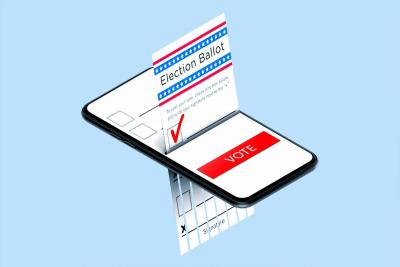Do a quick internet search for "fake news" and "the 2020 election." The results are alarming. Teaching students to learn to deal effectively with fake news is information literacy. As librarians and educators we have continued to learn and expand our information literacy knowledge. We work to teach our students to be skeptical, lateral searchers and fact-checkers.

In 2017, we presented a session at the American Association of School Librarians (AASL) Conference in Phoenix titled “Fake News Frenzy.” At the time, we had been following the phrase fake news and just really beginning to understand the ramifications of what we were seeing on social media and in other outlets. In hindsight, we should have known that in the four years that followed the 2016 election that misleading information, fake news and manipulated media instances would skyrocket.
As we write this in September, just shy of the 2020 presidential election, it is more important than ever that we prepare our students to be voter literate and that we explicitly teach the value of being information literate. Teaching these skills now, when they are so relevant to the history we are living, will be especially resonant and will allow students to apply an investigative lens to what they read and see.
In the weeks to come, encourage your students to think about the following — and to have meaningful conversations with family members and friends.
Manipulated media
The manipulation of media is taking place with ever-increasing frequency. Recently, lawyer and activist Ady Barkin, who speaks with the aid of a computer-generated voice, found his words being manipulated, spliced and utilized for a tweet by a politician. The video was edited to make Ady Barkin convincingly sound like he said something he did not.
Barkin later went on to write an op-ed for The Washington Post where he described the anger he felt at having his words manipulated, taken from him, and used against something he believes in. The video was marked as manipulated media by social media outlets — but even so, without keen information literacy skills, some may still believe it for truth.
In another manipulated media instance, a video of former Vice-President Joe Biden shared on social media showed him falling asleep during an interview. It was quickly outed as fake, but not before it was tweeted by White House Communications Director Dan Scavino and viewed by more than 2.4 million people.
In another instance, a clipped video, the president appears to be staring at a puddle and pointing; the caption questions his mental state. In reality, it was taken from a longer video where he was pointing out the puddle so that the First Lady would not step in it. Manipulation, short snippets and clips are happening on both sides of the political aisle, and we need our students to think critically about what they are seeing.
How do we teach this to young people? Pausing to employ information literacy skills and thoughtful evaluation is key. Check before you tweet. Check before you post. Does it seem too good to be true? Are other media outlets reporting the same story? Can you verify the facts elsewhere? What is the original source of the media? All these questions can help to stop the spread of misinformation.
Reuters has teamed up with Facebook to create a free course on identifying and tackling manipulated media. While you may find use for it in some high school classes, we think it’s a great way to dig into learning more about manipulated media for yourself to assist you in creating lessons for your students.
Memes
An acquaintance recently posted a meme online that, while semi-accurate, was missing some really important information. Politics, life and the world are far too nuanced and complicated to be summed up in a meme.
Have your students evaluate memes. Encourage them to dig deeper into the facts, find the background information behind the meme, and to think carefully before sharing half-truths and complicated issues that have been boiled down into a picture or a few short words.
Factcheck.org has an entire section dedicated to memes and misattributed quotes, ideas and the spread of misleading memes. One meme that circulated earlier this summer was an image of the White House with the caption that stated that the White House had gone dark while the president was taken to the bunker. The photo was actually from a 2014 picture. I can recall seeing this meme shared by friends on my timeline multiple times. As adults, we must do better so that our students can learn to be critical thinkers.
Information overload
Information comes at us at a speed that is astounding. We have updates pushed to our mobile devices; we can ask our smart speakers to play the news at any time. Sifting through all the noise is exhausting.
While keeping up with the news is great, taking a break and allowing yourself some downtime is a good idea as well. One piece of advice we can share with our students: it is OK to take a breather, think about what you heard or saw and come back to it later. This will allow them to not make snap decisions — such as reposting — without taking the time to fact check. Utilizing sites such as All Sides will assist in making the decision of what to accept as fact, fiction or something in between.
Echo chambers
David Robert Grimes of The Guardian writes, “Echo chambers are dangerous, we must break free of our online bubbles.”
Social media platforms have a vested interest in showing us what we want to see. Ensuring our students understand the algorithms behind their searches, their newsfeed, and why companies such as Google, Facebook and Twitter analyze our preferences and show us what we want to see is key. When we understand that we may be seeing only one side of the story, we can shift our behavior and seek out other resources and additional information.
Some suggestions for breaking away from an echo chamber that you can share:
- Broaden your horizons. Just knowing that you are seeing what social media wants you to see can make you more conscious of one-sided information.
- Adjust your feed preferences to include a variety of news sites, or take a look at All Sides, as mentioned above.
- Have actual conversations instead of solely relying on conversations via social media. Being able to talk though information is powerful.
Voter guides
Common Sense Media recently shared their Young Voter’s Guide to Social Media and the News. Common Sense provides lessons and tip guides for us to share with our students, staff and families.
The League of Women Voters has been around for close to 100 years and is another great source for information on voting, polls and voter locations. The organization provides candidate information down to the local level in a non-partisan way.
Finally, this quick guide shares multiple resources for voters.
As school librarians we are one of our school’s best resources for teaching our students to be voter literate. While our students may not yet be old enough to vote in the 2020 election, their family members, parents and friends may well be. Giving the gifts of information literacy and voter literacy will ensure our democracy has citizens who are truly prepared to participate in our electoral process. This November, vote as if your information literacy skills are driving you to the polls!



